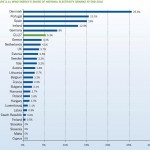 In 2010 wind power accounted 5.3% of the EU’s electricity demand, but this amount varies wildly from country to country across the continent. Denmark, Europe’s wind energy leader, is of course at the top of the table – wind power covers over one quarter of the country’s electricity demand. But the country in second position comes as a surprise. It’s not Germany or Spain, but Portugal – where wind energy accounts for an impressive 15.5% of the country’s electricity demand.
In 2010 wind power accounted 5.3% of the EU’s electricity demand, but this amount varies wildly from country to country across the continent. Denmark, Europe’s wind energy leader, is of course at the top of the table – wind power covers over one quarter of the country’s electricity demand. But the country in second position comes as a surprise. It’s not Germany or Spain, but Portugal – where wind energy accounts for an impressive 15.5% of the country’s electricity demand.
Most of Portugal’s wind power is located in the sparsely populated mountainous areas in the north-east of the country (all of its wind power is onshore). The country combines its wind energy with hydro power and some biomass to reach a level of 45% of electricity from renewable sources.
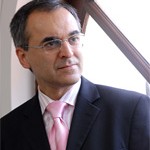 Wind power and other renewables can play a significant role in a new global “green economy” while also helping mitigate climate change between now and 2050, according to an exhaustive new report released on Monday.
Wind power and other renewables can play a significant role in a new global “green economy” while also helping mitigate climate change between now and 2050, according to an exhaustive new report released on Monday.
Produced by the United Nations Environment Programme (UNEP), the 624-page report identified the energy industry as one of the key sectors that will underpin a green economy.
The report said investing 2% of global GDP into the key sectors “can kick-start a transition towards a low carbon, resource efficient Green Economy” that replaces the “existing, resource-depleting, high carbon ‘brown’ economy” by mid-century.
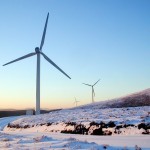 For wind energy aficionados, one of the most interesting stories to make its way across the internet last week involved an academic study claiming that the installation of 3.8 million 5 MW wind turbines could generate half the world’s power needs by 2030.
For wind energy aficionados, one of the most interesting stories to make its way across the internet last week involved an academic study claiming that the installation of 3.8 million 5 MW wind turbines could generate half the world’s power needs by 2030.
Published in the respected journal Energy Policy, and entitled ‘Providing all global energy with wind, water, and solar power,’ the study noted climate change, pollution, and energy insecurity are among the greatest problems of our time.
“Addressing them requires major changes in our energy infrastructure,” said the two California academics, Mark Z. Jacobson and Mark A. Delucchi. “Here, we analyse the feasibility of providing worldwide energy for all purposes (electric power, transportation, heating/cooling, etc.) from wind, water, and sunlight (WWS).”
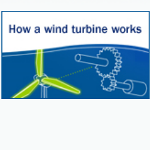 If you’ve ever asked yourself, or want to show someone else, how a wind turbine works, check out EWEA’s easy-to-use interactive tool.
If you’ve ever asked yourself, or want to show someone else, how a wind turbine works, check out EWEA’s easy-to-use interactive tool.
It allows you to play with the three main variables that determine how much electricity a wind turbine can produce:
The wind speed: Stronger winds produce more energy. Wind turbines generate energy at wind speeds starting from 4 metres per second (a gentle breeze) up to speeds of 30 metres per second (a violent storm). Over 30 metres per second (which happens rarely), the turbine is stopped from turning.
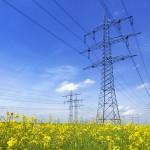
Imagine not being able to buy food or clothing from any country apart from your own. How boring – and expensive – our lives would be. Yet this is the case with most of our electricity. Because our power grids have few links between countries, 95% of power in Europe is consumed in the country in which it is produced.
An updated, Europe-wide power grid, with stronger, more numerous interconnectors, would allow wind power to be transported from wherever in Europe it’s blowing to wherever in Europe the consumers are, and open up cross-border trade in electricity.
Opening up the power market in Europe would have a far greater impact on thousands of consumers, bringing prices down as fuel-free wind power and other renewables would be preferred by the market to fossil fuels with unpredictable costs.
 In 2010 wind power accounted 5.3% of the EU’s electricity demand, but this amount varies wildly from country to country across the continent. Denmark, Europe’s wind energy leader, is of course at the top of the table – wind power covers over one quarter of the country’s electricity demand. But the country in second position comes as a surprise. It’s not Germany or Spain, but Portugal – where wind energy accounts for an impressive 15.5% of the country’s electricity demand.
In 2010 wind power accounted 5.3% of the EU’s electricity demand, but this amount varies wildly from country to country across the continent. Denmark, Europe’s wind energy leader, is of course at the top of the table – wind power covers over one quarter of the country’s electricity demand. But the country in second position comes as a surprise. It’s not Germany or Spain, but Portugal – where wind energy accounts for an impressive 15.5% of the country’s electricity demand.






 Comments
Comments



